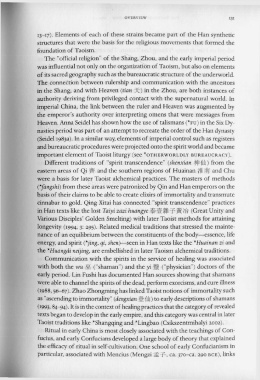Page 171 - The Encyclopedia of Taoism v1_A-L
P. 171
O VE RV I EW I31
I3- I7). Elements of each of these strains became part of the Han synthetic
structures that were the basis for the religious movements that formed the
foundation of Taoism.
The "official religion" of the Shang, Zhou, and the early imperial period
was influential not only on the organization of Taoism, but also on elements
of its sacred geography such as the bureaucratic structure of the underworld.
The connection between rulership and communication with the ancestors
in the Shang, and with Heaven (tian 7:.) in the Zhou, are both instances of
authority deriving from privileged contact with the supernatural world. In
imperial China, the link between the ruler and Heaven was augmented by
the emperor's authority over interpreting omens that were messages from
Heaven. Anna Seidel has shown how the use of talismans (*FU) in the Six Dy-
nasties period was part of an attempt to recreate the order of the Han dynasty
(Seidel I983a). In a similar way, elements of imperial control such as registers
and bureaucratic procedures were projected onto the spirit world and became
important element of Taoist liturgy (see *OTHERWORLDLY BUREAUCRACY).
Different traditions of "spirit transcendence" (shenxian ;fEll {w) from the
eastern areas of Qi 7fiY1 and the southern regions of Huainan 1l m and Chu
were a basis for later Taoist alchemical practices. The masters of methods
(*fangshi) from these areas were patronized by Qin and Han emperors on the
basis of their claims to be able to create elixirs of immortality and transmute
cinnabar to gold. Qing Xitai has connected "spirit transcendence" practices
in Han texts like the lost Taiyi zazi huangye ~§:9$rJt i€:1 (Great Unity and
Various Disciples' Golden Smelting) with later Taoist methods for attaining
longevity (I994, 3: 295). Related medical traditions that stressed the mainte-
nance of an equilibrium between the constituents of the body- essence, life
energy, and spirit (*jing, qi, shen)-seen in Han texts like the *Huainan zi and
the *Huangdi neijing, are embellished in later Taoism alchemical traditions.
Communication with the spirits in the service of healing was associated
with both the wu ffi ("shaman") and the yi ~ ("physician") doctors of the
early period. Lin Fushi has documented Han sources showing that shamans
were able to channel the spirits of the dead, perform exorcisms, and cure illness
(I988, 56-67). Zhao Zhongrning has linked Taoist notions of immortality such
as "ascending to immortality" (dengxian 1f:{W) to early descriptions of shamans
(I993, 84--94). It is in the context of healing practices that the category of revealed
texts began to develop in the early empire, and this category was central in later
Taoist traditions like *Shangqing and *Lingbao (Csikszentmihalyi 2002).
Ritual in early China is most closely associated with the teachings of Con-
fucius, and early Confucians developed a large body of theory that explained
the efficacy of ritual in self-cultivation. One school of early Confucianism in
particular, associated with Mencius (Mengzi Zir, ca. 370- ca. 290 BCE), links

